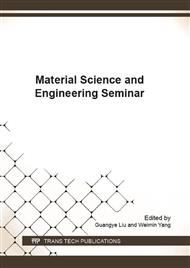p.9
p.14
p.22
p.27
p.32
p.38
p.47
p.52
p.57
Study on the Acquisition Method of Tire Rubber Parameters Based on Simple Shear Test
Abstract:
Tire simulation gradually becomes an important mean to ensure the quality of the tires. In order to guarantee the reliability of the analysis, the study on the method of obtaining the material parameters is also increasing. According to tire force situation of actual work, the acquisition method of tire rubber parameters based on simple shear test and its application in finite element analysis were studied in this paper. In this research, the international advanced dynamic mechanical analyzer was used to test the tire rubber, and the experimental results were processed by Yeoh hyper-elastic model. The hyper-elastic parameters and thus obtained could be used for finite element analysis of tires, and the simulation results showed that these parameters could be used to simulate the tire performance. In addition, the results could also provide certain guidance for the design and manufacture of tire.
Info:
Periodical:
Pages:
32-37
Citation:
Online since:
November 2016
Authors:
Price:
Сopyright:
© 2017 Trans Tech Publications Ltd. All Rights Reserved
Share:
Citation:


